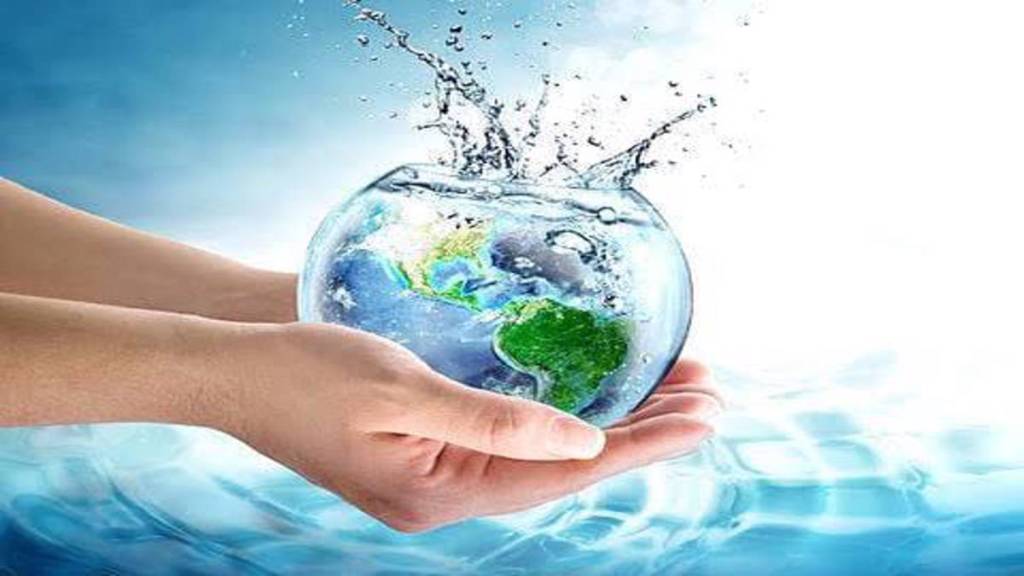By Poonam Sewak and Sambhaji Pal
Water is an essential natural resource for every form of life. Yet, it remains undervalued and inadequately managed worldwide. In India, 45 % of the workforce is employed in agriculture, contributing to about 18 percent of the GDP. But India uses two to three times more water per tonne of crop than several developed and developing nations, said Professor Ramesh Chand, Member of Government think tank Niti Aayog, on World Water Day 2024. The agriculture sector withdraws about 90% of all withdrawals. The country has low water use efficiency at 38% compared to the developed nations with irrigation project efficiency around 50 – 60%. According to the National Water Mission, India uses about 688 M3/MT of water for agriculture every year, the second highest in the world! And this must be reduced.
This is because 80 percent of the country’s farmers hold small pieces of land and are primarily dependent on rain, the failure of which leads to an everlasting threat of poverty and misery. Hence, an integrated approach towards all sources and uses of water is crucial.
Apart from tackling water scarcity, quick decisions have to be made that recognize, measure, and create awareness about the value of water, the failure of which is considered a prime cause of the mismanagement of water, according to the UN World Water Development Report 2021, published by UNESCO on behalf of the UN-Water.
To compound such scarcity, India has 18 percent of the world’s population living on 2.5 percent of the world’s land with access to 4.5 percent of the global water resources. However, over 29 percent (96.4 million hectares) of its total geographical area (328.7 million hectares) is degraded. Water is a pivotal input for healthy crop growth and is critical to food security.
Communities in India have realized the extent of soil degradation and have embraced the UN-prescribed Integrated Water Resources Management (IWRM) approach with the help of water warriors at Safe Water Network India (SWNI), an NGO. The United Nations defines IWRM as “a process which promotes the coordinated development and management of water, land, and related resources, to maximize the resultant economic and social welfare equitably without compromising the sustainability of vital ecosystems.”
IWRM is critical for the food security and livelihoods of the farmers. Its implementation by Safe Water Network India (SWNI) is holistically improving lives and livelihoods on the principles of 5Js – Jan and Jeevika (people and livelihoods), Jal (water), Jameen (land), Jungle (forest) and Jaanwar (Livestock).
In partnership with the National Bank For Agriculture And Rural Development (NABARD) SWNI have adopted a scientific approach to work hand-in-hand with the farmers. Data on weather, soil and plant health, moisture, utilization of organic manure, and the use of pesticides is collected and monitored. Under the IWRM, these help the farmers develop better cropping practices and stable livelihoods.
The local-level initiative helps farmers become climate resilient by preventing soil degradation, restoring water bodies, and planting trees and grass, especially to arrest desertification.
“The program has helped rejuvenate the farmland and provided water security despite severe drought conditions. The water resources are now fully accessible, equitable, managed, and governed by the village community,” said Srinath Dilip Ghadge Jal Kranti Village Watershed Committee in Maharashtra.
IWRM can similarly provide sustainable solutions to farmers across India, where water mismanagement has added to the already over-exploited one-sixth of the country’s groundwater reserves. More than 29 percent of the country’s geographic area is degraded, with a 40 percent loss of soil fertility. The initiative can be a boon to more than 600 million people facing acute water shortages in India, where the water demand is projected to be twice the available supply by 2030.
IWRM SOLUTIONS
Soil and water conservation measures such as continuous contour trenches (CCT), staggered contoured trenches (SCT), gully plugs, farm bunds, farm ponds, gabion structures, water absorption trenches, well recharge unit, groundwater recharge structures, check dams and pond rejuvenation can be adopted. Water absorption trenches, CCTs with vegetative barriers, were the best conservation measure to retain soil moisture even after the end of the monsoon.
Improved agriculture practices encourage the reduction of chemicals, fertilizers, and pesticides and promoting sustainable agriculture practices and organic manures. Jeevamrut, amrut paani, amrit khad proved the best interventions to optimize agriculture input cost and enhance agriculture productivity with improved soil health. Prudent crop selection to suit water availability and budgeting.
Soil health cards: A soil test is essential for several reasons: to optimize crop production, to protect the environment from contamination by runoff and leaching of excess fertilizers, to aid in the diagnosis of plant culture problems, to improve the nutritional balance of the growing media and to save money and conserve energy by applying only the amount of fertilizer needed. Soil test reports are further used to prepare soil health cards. A soil health card gives information on the soil’s nutrient status and recommendations on the nutrient dosage to improve its productivity and health. Sensors are used to test the soil and get immediate results. Soil sensors are useful in optimizing soil test cost as well as time.
Climate change adaptation measures such as real-time weather data-based agriculture advisories, improved climate-resilient crop varieties, less water-intensive and short-duration crop varieties, System of rice intensification, and system of wheat intensification can be applied to rain-fed agriculture, and the plantation of trees.
Automated Weather stations play an essential role in precision agriculture for various reasons. Small automatic weather stations can collect a variety of meteorological elements, standard temperature, humidity, rainfall, evaporation, atmospheric pressure, wind speed, wind direction, etc. Users can also add the meteorological elements that must be monitored according to their production needs. The construction and application of a small automatic weather station are of great significance in improving farmland meteorological monitoring, early warning service, effective defense against meteorological disasters, and implementation of precision agriculture.
Decision support: meteorological data provide agriculturalists with real-time and accurate climatic information, including temperature, humidity, precipitation, wind speed, etc. These data help agriculturalists in decision-making and planning, such as determining the appropriate planting period, fertilizer application period, irrigation amount, etc. By analyzing meteorological data, we can better understand the farm environment and rationally arrange farming activities to improve the yield and quality of crops.
Early warning of pests and diseases: meteorological changes impact the occurrence and spread of pests and diseases. Weather stations are able to provide weather indicators related to pests and diseases, such as temperature, humidity, etc., to help agriculturists provide timely warnings of the risk of pest outbreaks and the spread of pests and diseases. Through real-time monitoring of meteorological data and the combination of professional agricultural knowledge, appropriate control measures can be formulated to reduce the use of pesticides and the harm of pests and diseases to crops.
Water conservation management: Precipitation data provided by weather stations can help agricultural workers rationally arrange irrigation schedules to avoid over-irrigation and waste of water. According to the real-time precipitation and soil moisture content, the time, frequency, and amount of water for irrigation can be determined, achieving precise farmland water management and improving the efficiency of water use.
Village water budget: Addressing water security without proper accounting of water is a challenging task. The village water budget exercise gives proper insight into how much water occurs in a particular area and what water consumption is through various activities. The water budget exercise gives an overall picture of the water deficit or surplus in the assessed area. This helps to plan crop planning and other water usage-related actions. This initiative helps in driving community-led water stewardship initiatives.
Community capacity building and governance: It is well said that treatments on land, water, and livestock are easy, but it is very challenging to change community behaviors to sustain developed assets through projects. Community mobilization and awareness generation are important in sensitizing the community, bringing project ownership, sorting out community-level issues, and sustaining project interventions to yield long-term results. The formed community-based CBOs, like village watershed committees, play an important role in the operation and maintenance of created assets.
Women empowerment & livelihood generation activities: IWRM has provided a great opportunity for women and the landless community to participate in project activities since the beginning of the project. It helps to incorporate women and land-less related issues in project interventions and start working on it. Based on feasibility, several livelihood generation activities can be planned in the project area. These activities can create several income generation activities for women SHGs and landless families.
Countries all over the world have already decided to restore 1.5 billion hectares of degraded land by 2030 as part of a UN Convention. India is pushing to restore 26 million hectares of its degraded land by then. It has voluntarily pledged to achieve land degradation neutrality (LDN) by 2030, which means a stage where the amount and quality of land resources remain stable or increase within specified temporal and spatial scales and ecosystems, factoring in degradation and restoration.
By the year 2050, 1.7 to 2.4 billion people around the world will be seriously affected by water shortages, leading to conflicts between countries over water sharing and the growing incidence of extreme and prolonged droughts stressing the ecosystems, with dire consequences for both plants and animal species, says the UN. Through IWRM, India can show how to avert such conflicts and share frugal lessons with the world.
(Poonam Sewak is the Vice President of Programs and Partnerships, Safe Water Network and Sambhaji Palve is the Head of Integrated Water Resource Management. Views are personal.)









